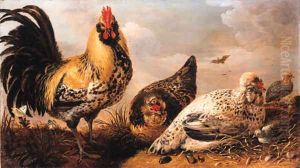Gijsbert Gillisz D'Hondecoeter Paintings
Gijsbert Gillisz d'Hondecoeter was a Dutch painter active during the Golden Age of Dutch painting, a period renowned for its rich tradition in the arts. Born in 1604 in Utrecht, Netherlands, into a family of artists, he was the son of Gillis Claesz d'Hondecoeter and would become part of a lineage of painters who specialized in depicting birds and other animals.
Gijsbert Gillisz was primarily known for his detailed and lifelike paintings of birds, following in the footsteps of his father, who also specialized in this genre. He became a member of the Utrecht Guild of Saint Luke, a professional association for painters, in 1628, which indicates that by this time, he had established himself as a master artist.
His works often feature a variety of birds, both domestic and exotic, set in naturalistic landscapes or garden settings. Gijsbert's ability to capture the textures of feathers and the liveliness of his subjects was admired, and his paintings were sought after by collectors who appreciated his attention to detail and the sense of tranquility his works conveyed.
D'Hondecoeter's career spanned a period of great prosperity in the Netherlands, which was then known as the Dutch Republic. This era, known as the Dutch Golden Age, saw a tremendous flowering of the arts, sciences, and trade, with artists such as Rembrandt, Vermeer, and Frans Hals contributing to a rich cultural legacy.
Gijsbert Gillisz d'Hondecoeter died in 1653, leaving behind a body of work that would influence subsequent generations of animal painters. His nephew, Melchior d'Hondecoeter, became the most famous of the d'Hondecoeter family of painters, often overshadowing the contributions of his uncle. Nevertheless, Gijsbert's work remains a testament to the specialized and highly skilled artistry of animal and bird painting in 17th-century Dutch art.
